Employee engagement is crucial to your organization’s success, but workplace motivation continues to be a challenge for employers. According to Deloitte’s Workplace Burnout Survey, 77% of respondents say they have experienced burnout at their current jobs.
Even the most passionate, motivated employees face burnout from time to time. The key is to avoid these slumps becoming recurring trends by learning how to motivate employees in the workplace. To help, we’ll share the essentials of motivating employees and highlight our top 12 favorite strategies for fighting disengagement.
If you’re building your employee motivation plan from scratch, don’t worry about immediately incorporating every strategy. Choose a handful to start with,

Why you should motivate employees
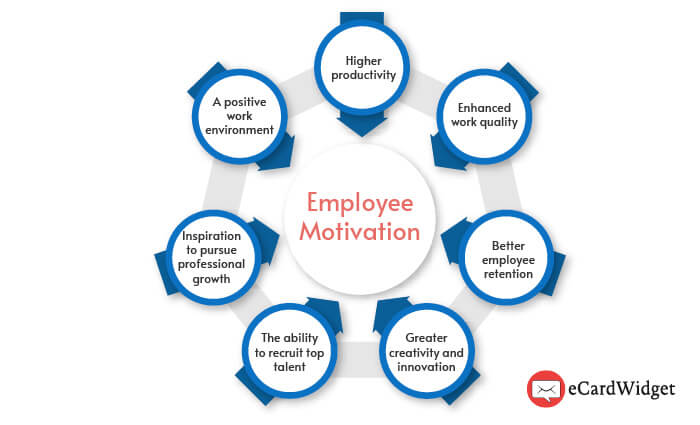
Motivating employees is essential to the success of any company. Happy, inspired employees can transform your workplace into a productivity powerhouse where people feel empowered by their work.
Here’s a quick overview of why every company leader should learn how to motivate employees:
- Enhance work quality. When you know how to motivate employees, you’ll inspire them to do their best work. They’ll dedicate themselves to producing high-quality outcomes and exemplifying company values.
- Boost employee retention. Satisfied and motivated employees are less likely to seek opportunities elsewhere, reducing turnover and the associated costs.
- Inspire creativity and innovation. Motivated individuals are more dedicated to their workplace and likely to think outside the box to help improve it.
- Attract top talent. Organizations known for proactively valuing their employees attract high-quality candidates. When you reward and motivate employees, word will get around to others.
In essence, motivating employees is beneficial for the individuals and pivotal for the overall success and growth of an organization. From inspiring your team to pursue professional growth to enhancing the day-to-day office atmosphere, you’ll start to notice a shift in company culture.
Signs You Need to Rethink Your Employee Motivation Strategies
You might be questioning when you should introduce employee motivation strategies to your company. The answer is now! You should always strive to keep your employees happy and inspired to work. However, there are a few instances in which a company should more proactively test these ideas out.
Here are some common signs of burnout and low workplace wellness:
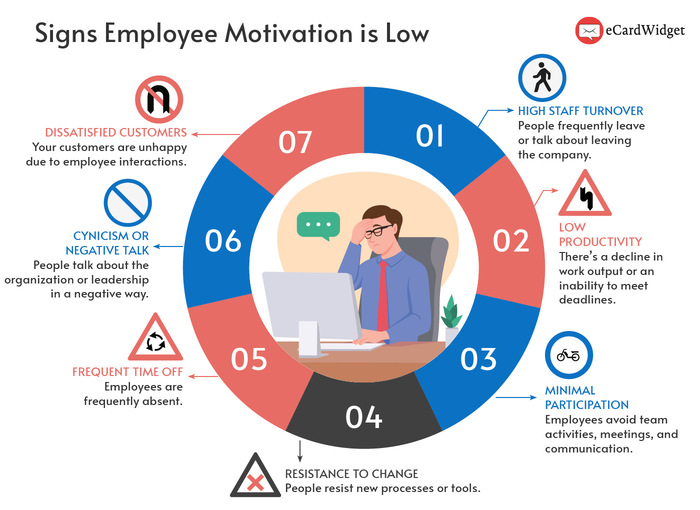
- High staff turnover: If people frequently leave your company, you have a motivation problem. Be aware of employees’ intentions to leave the job, company, or industry, and conduct exit interviews to learn the specific reasons.
- Low productivity: Look out for a decline in work output or a consistent inability to meet deadlines.
- Minimal participation: Avoiding team activities, meetings, communication, and brainstorming sessions may indicate a lack of enthusiasm.
- Resistance to change: This includes resisting new processes or tools that are introduced in the workplace.
- Frequent time off: If employees are frequently absent, they might be disengaged. In fact, Gallup found that highly engaged businesses have an 81% decrease in absenteeism.
- Cynicism or negative talk: Unmotivated employees may discuss the organization, its culture, or its leadership in a negative way.
- Dissatisfied customers: If your customer service stats are painful to look at, it might be worth looking into customers’ interactions with your team. Companies with engaged employees tend to have happy customers, according to a Harvard Business Review study.
Staying attuned to signs of demotivation enables managers and HR professionals to address potential motivation issues promptly. When left unaddressed, low motivation can lead to broader organizational challenges, including decreased performance or a toxic work environment.
Even if you’re not experiencing these issues, it’s a good idea to get ahead by proactively motivating your employees.
1. Create an employee recognition program.
Don’t underestimate the power of showing employees appreciation for a job well done and giving them proper recognition when they go above and beyond the call of duty. Regardless of what type of organization you run, whether it’s a business or nonprofit, your employees deserve to be appreciated for the great work that they do.
According to a Gallup and Workhuman report, employees who receive frequent recognition are 4 times more likely to be actively engaged at work and 5 times more likely to feel connected to their workplace culture.
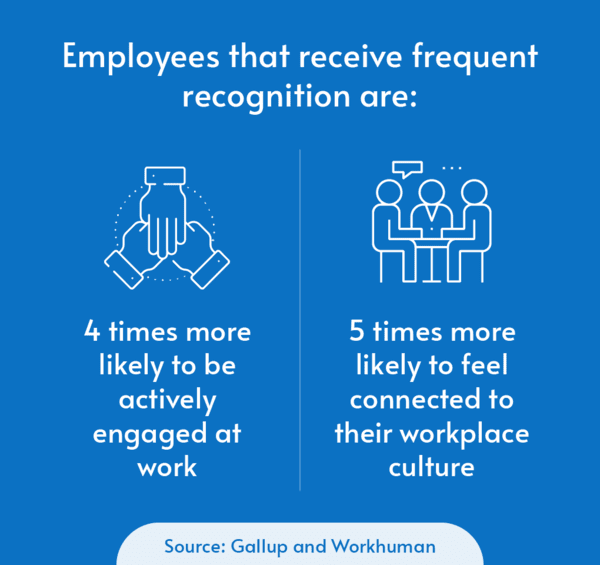
Creating a solid employee recognition program is an effective way to increase employee morale. Consider incorporating the following efforts into your employee recognition program:
- Send recognition eCards. Show your appreciation by sending employees a digital eCard when they’ve done an excellent job. A platform like eCardWidget makes it simple to create and send digital eCards without spending too much time on the design process.
- Recognize top employees during meetings. Take a couple of minutes at the start of your team meetings to spotlight the top employees of the week or month. This type of public recognition can make employees feel appreciated and inspire other team members to reach similar accomplishments.
- Create a culture of recognition. Don’t limit recognition to just manager/employee relationships. Encourage employees to show appreciation to each other when they notice someone doing great work. Allow employees to send eCards to each other to recognize their colleagues.
A little recognition can go a long way. Showing employees that you notice when they’re performing at a high level can motivate them to continue working hard.
An Example of How to Motivate Employees With Recognition
Recognition is especially effective when you align your messages with your company’s values. For example, check out these company culture eCards created by a financial technology company:
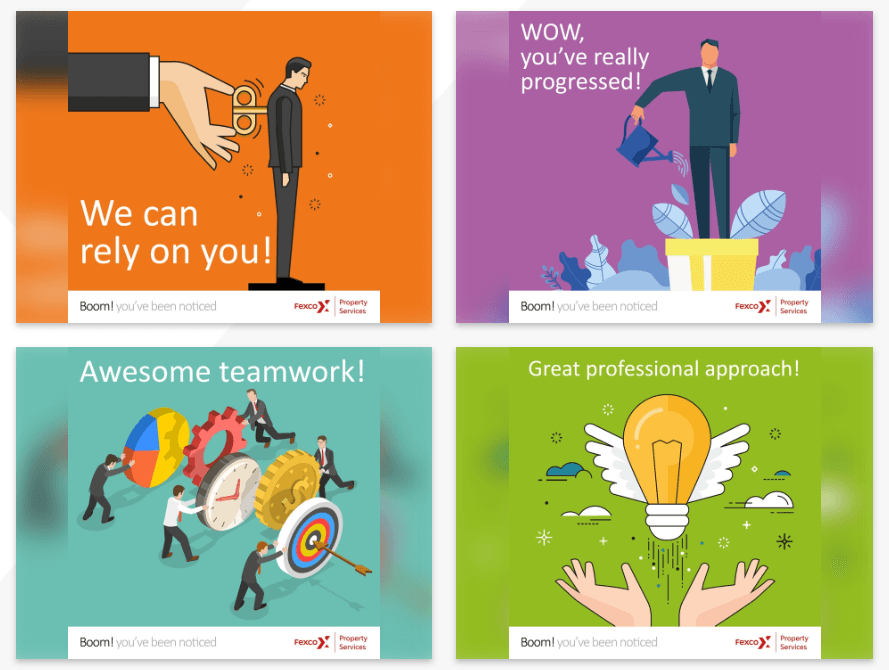
These cards helped leadership and peers express appreciation for specific values like teamwork, professionalism, and reliability. When you’re clear and specific about what employees are doing well, they’ll be motivated to continue excelling in that area.
Want to see how it works? Watch this video to learn how eCards make it easy to show your team members some appreciation:
All you have to do is add your business’s branding to eCardWidget’s design templates and embed your cards into your organization’s internal communications processes to get your eCard program up and running. In no time, you’ll have a valuable way to recognize hardworking employees.
Fexco isn’t the only company that’s experienced success with this strategy either. We’ve seen plenty of companies thrive with eCards as an employee motivation strategy.
2. Motivate employees with rewards and incentives.
In addition to giving employees praise when they’ve done well, it can also be highly motivational to offer incentives and prizes for higher performance. Consider motivating employees with monetary rewards like:
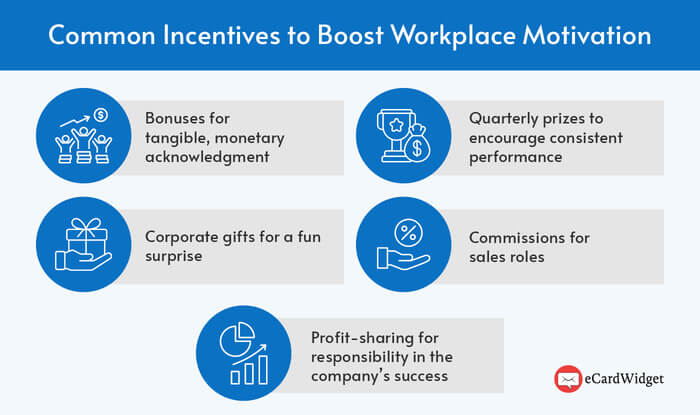
- Bonuses: Directly reward employees for hard work, dedication, and achieving target goals. Bonuses provide an immediate, tangible acknowledgment of an employee’s value to the company, incentivizing them to maintain or increase their efforts.
- Quarterly prizes: Give rewards out on a quarterly basis for achieving specific targets or to recognize outstanding performance. Quarterly prizes can keep motivation consistent throughout the year, as employees have goals at regular intervals to work toward.
- Corporate gifts: Give presents like merchandise or experiences as tokens of gratitude. Fun prizes add an element of surprise to anyone’s workday!
- Commissions: Commonly used for sales roles, enable employees to earn a percentage of the revenue they generate.
- Profit-sharing: Try giving employees a direct stake in the company’s success. Knowing they will benefit directly from the company’s profitability can motivate them to work harder for a bigger reward.
Be consistent and equitable with how you distribute incentives. Create a policy for monetary compensation and other tangible rewards to apply uniformly across your organization. Proactively communicate any changes to the policy so employees are fully aware of what type of incentives they can expect.
3. Help employees set professional goals.
Goal-setting is a crucial aspect of increasing employee motivation. When individuals have something to work toward that benefits both them and your organization, you can boost employee satisfaction and support your business’s overall success.
For example, managers can help employees set goals around:
- Positions they’d like to achieve: Help employees outline a progression path by identifying interim roles or responsibilities they should undertake to build towards their desired position. Then, connect the employee with colleagues who have relevant experience and can help mentor them.
- Projects they’d like to help complete: Understand what types of projects the employee is passionate about and match them with ones that align with their strengths and interests.
- New skills they’d like to develop: Identify workshops, courses, or seminars that can help employees gain relevant skills. Then, create opportunities for them to apply these new skills within their current role or on special projects.
Set goals during performance reviews to give employees big-picture objectives to prioritize. Make sure the goals you set with employees are SMART—specific, measurable, achievable, relevant to your organization’s overarching objectives, and time-bound.
4. Facilitate a path to growth.
If employees don’t have a clear path to growth, it can be difficult to envision a future with your organization that excites and inspires them.
Highlight growth opportunities based on each employee’s unique goals. For example, you might offer established employees new opportunities like:
- Management: Taking on a management role provides employees with greater responsibility and the opportunity to acquire new leadership skills. Being entrusted with more responsibility can make them feel valued for their competencies, boosting their confidence and morale.
- Larger or independently-led projects: Leading larger projects enables employees to impact the company’s objectives directly, while independently-led projects leave room for creativity and innovation, providing employees the space to try out their ideas.
- Peer-leadership opportunities: Even if it’s not a formal managerial position, leading peers can motivate employees by strengthening interpersonal relationships and improving team dynamics. Not to mention, they’ll be able to develop essential leadership skills like communication and delegation.
In essence, employers who offer roles like these send a strong message to their employees: they are trusted, valued, and seen as vital contributors. When employees feel excited about future opportunities with your organization, they’ll have a greater drive to perform their best.
5. Provide training opportunities to motivate employees.
Engaging employees in ongoing training doesn’t just help your business run more efficiently. It can also boost employee job satisfaction and retention. 68% of workers surveyed in a University of Phoenix study say they would stay with their employer throughout their careers if the employer helped upskill them.
With that in mind, consider offering professional development opportunities like:
- Coaching and Workplace Mentoring:Offer personal guidance and support within your company to foster skill development and career growth.
- Specialized Training Courses: Create programs designed to enhance specific skills or knowledge areas, ensuring employees pursue personal growth in their field.
- Opportunities to Attend Conferences: Send employees to industry gatherings where they can gain insights, network with other professionals, and stay informed about the latest trends and advancements.
- Association Membership for Your Employees: Pay for employees to join professional organizations that offer resources, networking opportunities, and industry credibility.
Employees will feel more motivated to perform at the top of their game when they have the skills and knowledge to do so. Try offering training opportunities and encourage employees to share any others they’re interested in.
6. Involve employees in decision-making.
According to Slack’s Future of Work study, 80% of workers want to know more about how decisions are made in their organization, and 87% want their future company to be transparent.
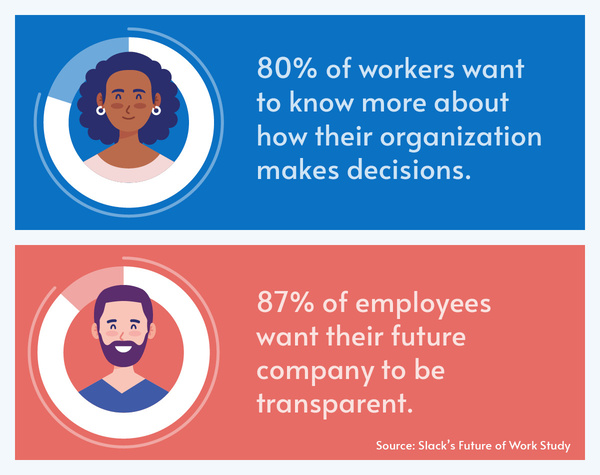
Give employees a greater stake in your organization’s success by engaging them in decision-making and setting business priorities with these strategies:
- Work with employees to set business goals and priorities. Involve employees in the goal-setting process and give everyone their own role in working toward business priorities.
- Ask for employee feedback and ideas regularly. Incorporate their ideas when possible and provide an explanation when suggestions are rejected.
- Providing context for business decisions. When you have to make a decision that goes against many employees’ wishes, provide context for why the choice was made. This can help reduce confusion and misunderstandings.
Employees may not agree with every decision your leadership makes, but they should be given the opportunity to understand why the choices were made and make their voices heard in the decision-making process.
7. Motivate employees by providing flexibility.
The prevalence of remote and hybrid work has skyrocketed, with 74% of U.S. companies using or planning to implement a permanent hybrid work model. Nowadays, flexible work policies aren’t just nice-to-have benefits—for many employees and job seekers, they’re a must-have.
Here are a few ideas for flexible work policies to incorporate at your business:
- Flexible work location policy. If possible, offer hybrid or even fully remote working options. 68% of Americans say they would prefer to be fully remote, so consider if remote work is a possibility for your business.
- Flexibility in how employees can manage their projects/workflow. If your business’s structure allows for it, provide opportunities for employees to work on their tasks in the order that best suits their working style.
- Flexible working hours. Employees might have other commitments that mean that they won’t be able to work from 8 to 5 every day. Allow for flexibility in workday start and end times so employees can take care of their personal priorities.
Flexible work arrangements help employees manage burnout and maintain a better work-life balance, which can boost their motivation during working hours.
8. Contribute to social good.
Employee engagement levels are 13% higher at companies that invest in corporate social responsibility programs, which means a surefire way to motivate your employees is by contributing to social good.
When it comes to establishing a corporate social responsibility (CSR) program for your company, the opportunities are endless. Motivate employees to get involved through:
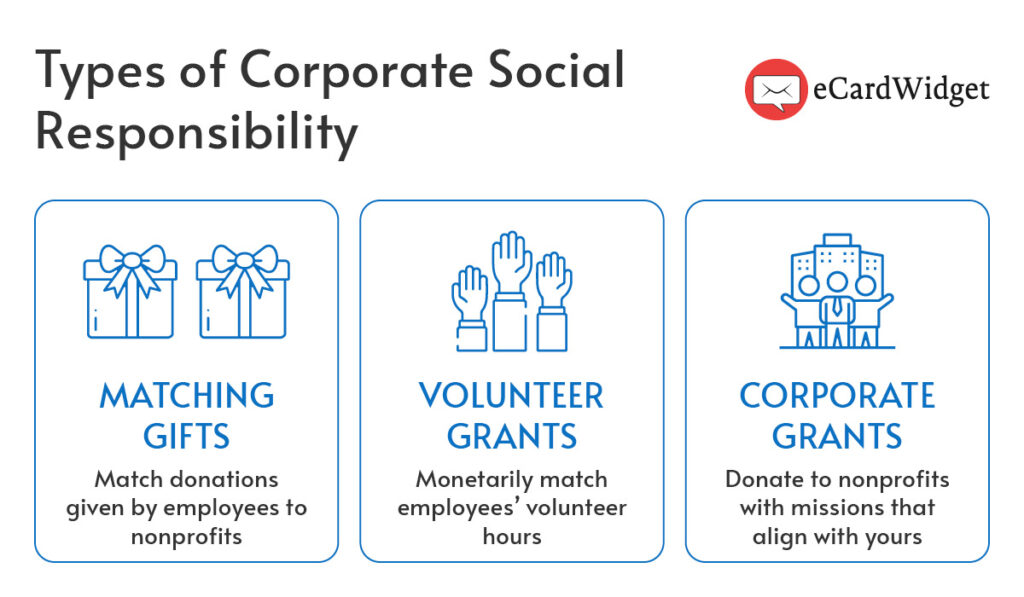
- Matching gifts: Contribute to a nonprofit after an employee makes a gift. You can directly match their gift, double their gift, triple it, or choose another ratio that would maximize their donation.
- Volunteer grants: Give a monetary gift to a nonprofit as a result of an employee volunteering a set number of hours with that organization.
- Corporate grants: Set up a grant program to fund nonprofits whose missions align with yours. Donate funds to specific causes that promote the welfare of others.
Prominent examples of companies with corporate philanthropy initiatives include Microsoft, Google, and Apple. You can use these examples as a framework for developing your own program or look inward by asking your employees about their charitable involvement. By showing interest in your employees’ philanthropic endeavors, you’ll show that you care not just about their hobbies and interests, but about their deeply rooted values and the causes they’re passionate about.
9. Motivate employees by emphasizing collaboration.
Teamwork is scientifically proven to boost productivity and team member satisfaction. As humans, we naturally crave social interaction. When you encourage collaboration, employees will develop camaraderie, share a couple of laughs throughout the day, and feel comfortable asking for help.
Offering opportunities for teamwork at your workplace allows employees to:
- Emotionally support each other. Working as a team allows employees to unite under common goals and feel responsible for the team’s collective performance. By supporting one another, they’ll ultimately foster a sense of purpose and belonging.
- Gain better listening skills. Working collaboratively means employees can break out of their echo chambers by listening to others. They’ll feel compelled to hear others’ opinions and suggestions.
- Come up with new ideas and innovative ways to solve problems. We’ve all heard the phrase, “Two heads are better than one.” Bouncing ideas off each other is a wonderful way to motivate peers, come up with creative solutions, and establish a collaborative work environment.
When your team works well together and gets along, employees will feel motivated to do their best to support their colleagues. Overall, encouraging teamwork will provide a supportive environment where employees face challenges collectively, celebrate achievements together, and feel integral to the success of the whole organization.
10. Foster a culture of positivity.
Along with facilitating teamwork, developing a positive workplace culture makes employees feel energized about their roles.
Promote camaraderie in your workplace by:
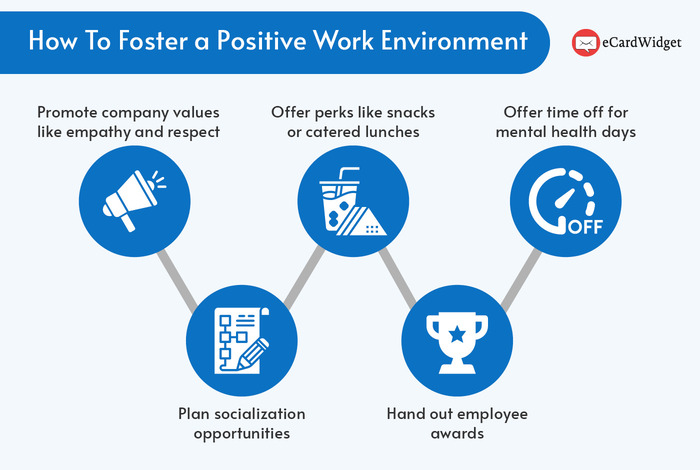
- Maintaining a positive outlook. Ensure your leaders promote values like positivity, empathy, and respect. Treat mistakes graciously, maintain healthy boundaries, and deal with interpersonal issues fairly and equitably.
- Planning employee engagement and socialization opportunities. Your employees may not all be best friends, but social opportunities can be great icebreakers that improve team harmony. For example, you can plan team bonding events like an escape room or host a quarterly dinner out at a local restaurant.
- Offering fun work perks like snacks at the office or catered lunches. If employees work on-site at your office, offer a few in-office perks like free coffee, tea, snacks, and catered lunches.
- Giving out employee awards. Commend your outstanding employees by calling them out for their hard work. You can develop fun awards like the ‘Team Choice Award’ or ‘Culture Ambassador’ to celebrate their workplace accomplishments.
- Providing employees with time off for mental health days. Let employees recharge by encouraging them to use their PTO for mental health days when needed.
By fostering an engaging, easygoing workplace, you can help employees fight burnout and feel more comfortable at your organization.
11. Promote corporate giving opportunities.
Employees feel better about going to work every day when they know their employer is positively impacting the world. This could be through corporate social responsibility (CSR) initiatives like sponsoring nonprofits, participating in charity affiliate programs, or providing in-kind donations of equipment and services.
Research the connection between employee engagement and CSR is also quite thorough, with reports showing that:
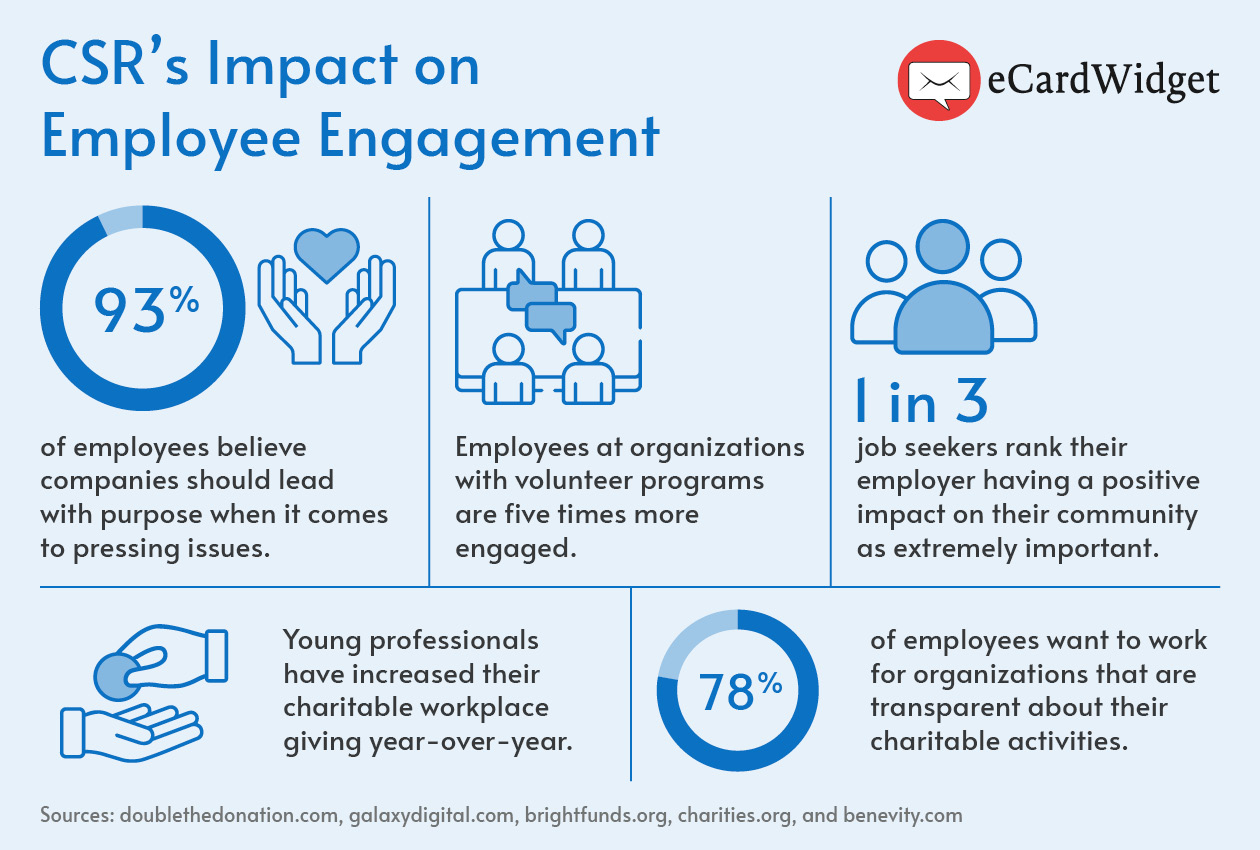
- 93% of employees believe companies should lead with purpose regarding pressing issues, like environmental and social concerns.
- Employees at organizations with volunteer programs are five times more engaged.
- 1 in 3 job seekers rank their employer as having a positive impact on their community as extremely important.
- Young professionals have increased their charitable workplace giving year-over-year.
- 78% of employees want to work for organizations that are transparent about their charitable activities.
Prioritize strategies for getting employees involved with CSR directly. Consider launching initiatives like:
- Matching gift programs. Encourage participation in your employee giving program by matching your staff’s donations to nonprofits. Decide which causes you’ll support, how much you’ll match per year per employee, and when employees need to submit their matching gift request application.
- Corporate volunteer days. Invite employees to get out in their community and lend their time and effort to nonprofits in need. Corporate volunteer programs come in several forms, as well. You can arrange volunteer days with nonprofits where your entire team goes out to volunteer during work hours, or you can give employees volunteer time off, which are designated PTO days they can take to volunteer.
- Employee grant stipends. Make donating easy by giving money to employees for them to donate. Employee grant stipends are funds given to employees that are specifically marked for donating, and employees can then give them to the nonprofit of their choice. This approach eases the financial burden of donating since employees won’t need to sacrifice part of their paychecks to give back.
Structured initiatives make participating employees feel like they have an opportunity to help their community thanks to their employer. Other CSR programs like improving supply chain sustainability and sponsoring nonprofits are useful too, but many employees also like getting the chance to be part of a hands-on program.
12. Encourage autonomy.
It may sound counterintuitive, but sometimes the best way to engage employees is to back off and let them manage their work themselves. Along with appreciating flexibility, many employees also like having the independence to decide what they’ll work on, how they’ll approach their tasks, and what ideas they’ll try.
Encouraging autonomy isn’t just about reducing micromanaging, though your company should also aim to do that. Rather, the goal is to allow employees to take ownership of their work, increasing their investment in completing it and ensuring it’s high quality.
A few ways you can do this include:
- Promote creativity. Your employees likely have a lot of thoughts about their day-to-day work, so let them try out new ideas by promoting creativity and innovation. Encourage creative solutions or give trusted employees more open-ended projects that are theirs to shape.
- Let employees design their work processes. Unless your business is in an industry with very strict regulations about certain work processes, give your employees the freedom to manage and approach their work how they want to. Provide some restraints, such as specific deadlines or project requirements, but otherwise, let them control their schedules and workflow.
- Encourage risk-taking. Not every idea your employees have will be a winner, but make sure they’re not afraid to try a new solution. When it comes to encouraging risk-taking, be clear about what is an acceptable risk, such as potentially having to redo part of a project, and what isn’t, such as a safety hazard, to make sure everyone’s on the same page.
When it comes to promoting independence, be aware that not all employees will be ready for full control right out of the gate. Experienced employees will likely appreciate the breathing room, but be prepared to give newer staff more direction until they have their core responsibilities down.
Final Thoughts on Motivating Employees to Give It Their All
Fostering employee motivation helps improve multiple aspects of your business, from facilitating new employee recruitment to boosting employee retention.
Hopefully, some of these tips resonate with you as potentially effective ways to help boost employee morale and motivation at your workplace. Even starting with something as simple as recognizing employees with digital eCards can lift your team’s spirits.
Looking for more tips on how to boost employee engagement and retention? Start with these resources:
- Customer Appreciation Gifts That Go Beyond Discounts. Just like employees, your customers need to feel valued. Explore thoughtful appreciation gifts that speak volumes. You can even use these gifts to boost employee morale, too.
- 15+ Special Employee Appreciation Day Ideas You Need to Try. Celebrating Employee Appreciation Day is a great way to increase employee motivation and retention. Explore several engaging ways to show appreciation and celebrate in style.
- Employee Retention: Best Practices & Key Steps. Employee retention is a comprehensive process that starts as early as new employee recruitment and onboarding. Learn about the best ways to retain your employees with this guide.



